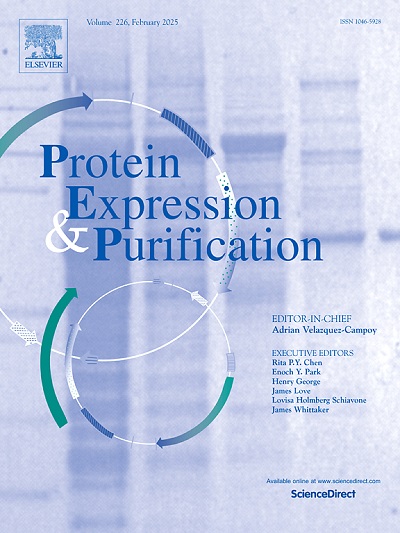Cloning, expression, and characterization of collagen galactosyltransferases from human, sponge, and sea walnut
IF 1.2
4区 生物学
Q4 BIOCHEMICAL RESEARCH METHODS
引用次数: 0
Abstract
Collagen is an extracellular matrix protein conserved across animals and viruses, with its function regulated by post-translational modifications of lysine residues. Specifically, certain lysine residues in collagen are hydroxylated to form hydroxylysine, which serves as an attachment site for hydroxylysine-linked glycosylation. This glycosylation process is initiated by collagen galactosyltransferases from the GT25 family, also known as GLT25D or COLGALT proteins. Despite their biological importance, efficient methods for expressing and isolating GLT25Ds have yet to be fully developed, and the biochemical mechanisms underlying their function still need to be better understood. To address this, we performed sequence alignment and phylogenetic analyses of GLT25Ds across vertebrates, invertebrates, and viruses. Using sponge (amphimedon queenslandica) GLT25D as a model, we established a bacterial expression, purification, and assay protocol. Sponge GLT25D expressed robustly in E. coli strain BL21 and demonstrated enzymatic activity comparable to human GLT25D1 from mammalian cells. Kinetic parameters and the effects of time, temperature and pH on enzymatic activity were characterized for both enzymes. AlphaFold structural modeling and sequence alignment revealed an EXD motif and a conserved leucine in a pocket of the second Rossmann-fold domain of sponge GLT25D, suggesting this pocket as the active site. Using the standardized bacterial expression, purification, and assay protocol, we screened GLT25Ds from various vertebrate and invertebrate species. Notably, the sea walnut (mnemiopsis leidyi) GLT25D exhibited superior expression levels and robust enzymatic activity. This established method provides a strong foundation for future bioengineering efforts, structure-function analyses, and the development of GLT25D inhibitors.
人、海绵和海核桃胶原半乳糖转移酶的克隆、表达和特性分析。
胶原蛋白是一种跨动物和病毒保守的细胞外基质蛋白,其功能受赖氨酸残基翻译后修饰的调节。具体来说,胶原蛋白中的某些赖氨酸残基被羟基化形成羟赖氨酸,羟赖氨酸作为羟赖氨酸连接糖基化的附着位点。这种糖基化过程是由GT25家族的胶原半乳糖转移酶(也称为GLT25D或COLGALT蛋白)启动的。尽管glt25d具有重要的生物学意义,但有效的表达和分离glt25d的方法尚未完全开发,其功能的生化机制仍有待进一步了解。为了解决这个问题,我们在脊椎动物、无脊椎动物和病毒中对glt25d进行了序列比对和系统发育分析。以海绵(amphimedon queenslandica) GLT25D为模型,建立了细菌表达、纯化和检测方案。海绵GLT25D在大肠杆菌菌株BL21中稳定表达,并显示出与哺乳动物细胞中人类GLT25D1相当的酶活性。研究了两种酶的动力学参数以及时间、温度和pH对酶活性的影响。AlphaFold结构建模和序列比对显示,海绵GLT25D的第二Rossmann-fold结构域存在一个EXD基序和一个保守的亮氨酸,表明该口袋是活性位点。使用标准化的细菌表达、纯化和测定方案,我们从各种脊椎动物和无脊椎动物物种中筛选了glt25d。值得注意的是,海核桃GLT25D表现出更高的表达水平和强大的酶活性。该方法为未来的生物工程、结构-功能分析和GLT25D抑制剂的开发提供了坚实的基础。
本文章由计算机程序翻译,如有差异,请以英文原文为准。
求助全文
约1分钟内获得全文
求助全文
来源期刊

Protein expression and purification
生物-生化研究方法
CiteScore
3.70
自引率
6.20%
发文量
120
审稿时长
32 days
期刊介绍:
Protein Expression and Purification is an international journal providing a forum for the dissemination of new information on protein expression, extraction, purification, characterization, and/or applications using conventional biochemical and/or modern molecular biological approaches and methods, which are of broad interest to the field. The journal does not typically publish repetitive examples of protein expression and purification involving standard, well-established, methods. However, exceptions might include studies on important and/or difficult to express and/or purify proteins and/or studies that include extensive protein characterization, which provide new, previously unpublished information.
 求助内容:
求助内容: 应助结果提醒方式:
应助结果提醒方式:


